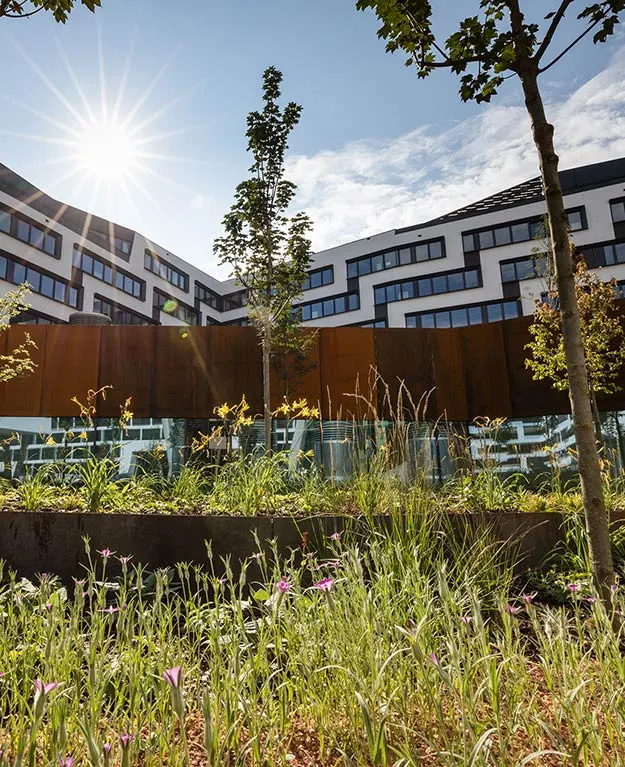Our headquarter
It covers a larger area than the Pentagon in Washington and can provide employment for several small towns The new AUSTRIA CAMPUS in the second municipal District of Vienna.
The new headquarters of the UniCredit Bank Austria at the AUSTRIA CAMPUS is the location of UniCredit Bank Austria, Vienna-based UniCredit CEE divisions and all UniCredit affiliated companies in Vienna. Around 5,300 employees are experiencing a completely new working environment here. In two buildings with approximately 60,000 square metres of office space.

At our new headquarters you will discover an office landscape that suits contemporary working life well. Open working spaces in large and bright rooms with the latest technology - embedded between green areas that can also be used as recreational zones.
Austria Campus was built by SIGNA and designed by the renowned architect Boris Podrecca. The new headquarters of UniCredit Bank Austria were customised by UniCredit while taking modern work organisation into consideration.
The location is perfectly connected to Vienna’s public transport network It can be reached quickly through the Praterstern transport hub via the underground train network, trains, trams and buses. Further benefits: The quick connection to Vienna-Schwechat airport.

Ecology and sustainability
The entire Austria Campus has been designed with the highest attention to ecological and sustainability criteria, and since 2019 the building has been officially certified with DGNB Gold (the Austrian Society for Sustainable Real Estate Management). LEED Gold certification as a green building is also being sought, and the test procedure is expected to be completed in the coming months. In addition, we are setting a particular example in terms of ecological sustainability: our own geothermal energy plant on the Austria Campus is one of the largest private facilities in Europe for the generation of geothermal energy. This energy is used in summer and winter to support heating and cooling while complying with all environmental regulations. The state-of-the-art ventilation and shading system is also worthy of mention, which contributes fully automatically to the most efficient cooling and heating of the building.

The Environmental Management System
The environmental management system according to ISO 1400:2015, which has been in place since 2011, is also essential for our environmental performance, which has been continuously improved over the years, and will continue to make a significant contribution to the most ecological use of our new headquarters in the future.
Sustainability also plays a major role in the design of the new working environment. In addition to the low-paper office with centrally located printer islands, a modern waste separation system, for example, helps to reduce the amount of waste and collect recyclable materials for recycling.
Further information on building certification can be found here.

"Our new headquarters are setting standards for modern working and the cooperation between our bank’s teams, and with colleagues in the UniCredit Group. In this way we want to strengthen both our customer focus and employee satisfaction. By concentrating all the central divisions at this cutting-edge location we are able to achieve clear, positive cost effects in accordance with our plan ‘Transform 2019’. At the same time this is a new, open, and modern working organisation built on the basis of ‘Smartworking’, an expression of our idea of an innovative and future-oriented corporate culture."

Reducing the ecological footprint
By moving to the Austria Campus, we were able to significantly reduce our total energy consumption (heating and electricity) from 2018. This was achieved on the one hand by concentrating all central units at the site, on the other hand by the ecological construction of the new headquarters and last but not least by the geothermal energy plant we built, which uses geothermal energy all year round to support heating and cooling.
A glance at the figures clearly shows the extent of the savings: for example, heating energy requirements at the central locations were reduced from 2017 (the year before the Austria Campus relationship) to 2019 (the first full year at the new headquarters) by around 24,000,000 kilowatt hours (kWh) or 84% to around 4,500,000 kWh. This would enable about 52,000 people to cover their annual hot water requirements. This corresponds approximately to the population of St. Pölten.
As far as electricity consumption is concerned, the picture is just as positive: Compared to the total electricity consumption of all central locations in 2017, the consumption for the Austria Campus in 2019 showed a saving of almost 33,000,000 kWh. This means that every St. Pölten resident could leave more than one flat-screen TV switched on around the clock for one year (electricity consumption of 62,000 flat-screen TVs).
Apart from the offices the campus also accommodates:
- a canteen
- a kindergarten
- a medical center
- an events hall
- a hotel
- a Bank Austria branch
- as well as a SB (Selbstbedienungs [self-service]) branch
- and a staff centre.
New part of town around the Nordbahnhof in Vienna
The whole project is also a commitment to Vienna as a location: by 2025 a new city area will be developed around the Nordbahnhof with a total area of 85 hectares. The area will be marginally smaller than Vienna Airport which is 100 hectares. The 10,000 subsidised flats, the privately financed homes, and 20,000 jobs will create a new, urban living area in the city district.





